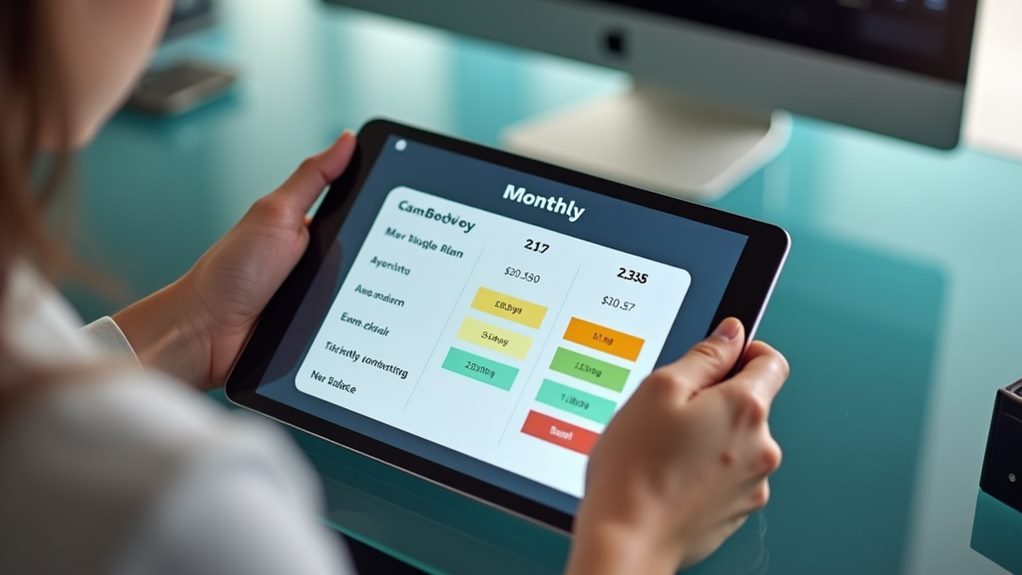Yes, you'll need to pay monthly charges for VoIP services, typically ranging from $5 to $40 per user based on your selected plan and features. The pricing structure follows a tiered subscription model where costs scale with functionality and team size. Your actual expenses may increase by 20-30% due to regulatory fees, taxes, and add-on features like video conferencing. However, VoIP systems still offer approximately 60% cost savings compared to traditional phone lines. Volume-based discounts become available when you have 20+ users. Understanding the complete fee structure will help you select the most cost-effective solution for your needs.
Monthly VoIP Pricing Explained

Monthly VoIP pricing operates on a tiered subscription model, with costs ranging from £5 to £40 per user depending on your selected service level. Your monthly VoIP subscription costs will typically include core features, but you'll need to account for additional monthly line rental fees between £10 to £50 per user.
VoIP technology not only helps reduce phone bills considerably—saving businesses approximately 30% compared to traditional lines—but also eliminates expensive landline setup fees, leading to immediate savings and operational efficiencies cost savings and affordability.
When you're evaluating how VoIP providers charge, you'll discover setup costs that include VoIP-compatible phones ranging from £35 to £300. While these are one-time expenses, they're vital to factor into your initial budget planning. Your VoIP phone service becomes more cost-effective when you leverage volume-based discount savings. Organizations with 20+ or 50+ users often qualify for notable reductions in their per-user rates.
Don't overlook hidden fees when calculating your total monthly costs. State sales taxes and regulatory recovery charges can add £10 or more to your monthly VoIP subscription costs.
The number of users in your organization directly impacts your pricing structure, so it's important to accurately assess your team size and growth projections when selecting a plan. This guarantees you're maximizing cost efficiency while maintaining necessary service levels.
Understanding VoIP Service Plans
VoIP service plans operate on a multi-tiered subscription framework, where you'll find standard packages ranging from £5 to £40 per user based on functionality requirements.
As a business owner, you'll need to take into account monthly charges that typically fall between $15 and $35 per user, though some providers offer basic pricing plans starting at $10 monthly. Your line rental and user fees will greatly impact your organization's overall communication expenses.
It's crucial to recognize that VoIP costs are generally 60% lower than traditional systems, making them a lucrative alternative for cost-conscious businesses lower installation costs.
When evaluating VoIP providers' offerings, take into account these crucial components:
- Monthly subscription costs that scale with your team size, potentially offering considerable savings when you reach 20+ users
- Line rental fees ranging from £10 to £50 per user, which form part of your recurring monthly charges
- Advanced features pricing, including specialized tools for call quality management and sophisticated routing systems
- Volume-based discounts that can markedly reduce per-user costs for larger deployments
Understanding these pricing structures helps align your business requirements with the right service tier.
Most VoIP providers offer customizable packages that let you select specific features while maintaining cost efficiency. This flexibility guarantees you're only paying for the capabilities your organization needs.
Hidden Costs and Additional Fees

In addition to standard subscription fees, users must account for several concealed expenses that can substantially impact the total cost of VoIP implementation. Your base monthly subscription fees for VoIP services typically range from $20 to $40 per user, but you'll need to factor in additional monthly fees that aren't always immediately apparent, including cost savings and financial benefits.
You'll encounter regulatory recovery fees, state sales taxes, and E911 charges that can add $10 or more to your monthly bill. Hidden fees can increase your VoIP costs by 20% to 30% beyond the advertised price, affecting your organization's budget planning.
When you're considering feature add-ons like video conferencing and advanced call routing capabilities, you're looking at extra charges ranging from $5 to $100 monthly, depending on your specific requirements.
Don't overlook number porting expenses, which often come with one-time fees during the conversion process. As part of your VoIP community, you'll want to carefully review your service agreement and scrutinize all potential taxes and fees before committing.
Being thorough in your cost analysis helps you avoid unexpected charges and guarantees you're getting the most value from your VoIP investment.
Comparing Different VoIP Providers
Leading service providers in the VoIP market offer distinctly different pricing structures and feature sets that require systematic comparison. When you're evaluating VoIP providers, you'll find monthly charges ranging from £5 to £40 per user, with subscription packages varying considerably in their offerings.
Most providers implement tiered pricing plans that align with your organization's communication requirements.
To effectively compare VoIP services, focus on these critical factors:
- Base subscription costs and included features – examine which providers bundle essential call controls and voicemail in their standard packages.
- Volume discounts availability – assess providers offering reduced rates for 20+ or 50+ users to maximize cost efficiency.
- Advanced functionalities pricing – evaluate additional costs for features like video conferencing and team chat integration.
- Hidden fees assessment – calculate the true cost by factoring in taxes and regulatory fees that can increase monthly charges by 20-30%.
Your comparison should include an analysis of international calling rates and scalability options.
Consider providers offering flexible minute packages, from 100 to unlimited minutes, ensuring your selected service can grow with your business while maintaining cost-effectiveness through proper utilization of volume discounts.
Selecting Your VoIP Payment Structure

Your organization's VoIP payment structure requires careful consideration of both immediate costs and long-term financial implications.
When evaluating monthly charges, you'll find that VoIP plans typically range from £5 to £40 per user, with pricing variations based on selected provider features and service tiers.
To optimize your VoIP expenses, you'll need to assess your usage patterns and select the most cost-effective plan.
Business VoIP options often include tiered structures like Voipfone 100, 500, and Unlimited, each designed to match different organizational needs.
For larger deployments, you can leverage subscription costs discounts when registering 20 or more users under a single account.
Consider the advantages of annual payment options, which frequently offer reduced monthly pricing compared to month-to-month arrangements.
You'll want to analyze your organization's cash flow and user volume to determine whether committing to a longer-term contract makes financial sense.
Remember that residential VoIP plans, while typically including VAT, offer different pricing structures than business VoIP services.
Final Thoughts
You'll find VoIP monthly charges vary considerably based on your selected service tier and provider, much like traditional phone systems of the past. For ideal cost management, you'll need to calculate your baseline requirements, factor in potential scaling needs, and evaluate per-user pricing structures. Don't overlook SIP trunking fees, QoS upgrades, and bandwidth requirements when configuring your final VoIP budget parameters.

